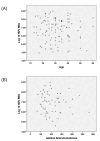Community-Based Double Reflex Screening Reveals Widespread Hepatitis D Viremia Among Hepatitis B Surface Antigen Carriers in Pakistan
- PMID: 40458382
- PMCID: PMC12127032
- DOI: 10.7759/cureus.85200
Community-Based Double Reflex Screening Reveals Widespread Hepatitis D Viremia Among Hepatitis B Surface Antigen Carriers in Pakistan
Abstract
Background Hepatitis D, caused by the hepatitis delta virus (HDV), poses a significant public health concern in many parts of the world. However, HDV screening remains suboptimal in most regions, leading to underdiagnosis of the infection. This study aimed to determine the prevalence of HDV infection through double reflex testing of hepatitis B surface antigen (HBsAg)-positive individuals at screening camps in two high-prevalence towns in the eastern part of Balochistan province, Pakistan. Methods A total of 1,643 individuals were screened for HBsAg and antibodies to the hepatitis C virus (anti-HCV). Those who tested positive for HBsAg were further tested for antibodies to HDV (anti-HDV). Samples positive for anti-HDV were subsequently analyzed for HDV RNA using real-time PCR. Results Of the 1,643 individuals screened, 277 (16.9%) tested positive for HBsAg and 227 (13.8%) for anti-HCV. Among the HBsAg-positive individuals, 186 (67.1%) were positive for anti-HDV antibodies, including 133 men and 53 women, with a mean age of 32.2 ± 11.3 years. HDV RNA was detectable in 108 (58.1%) of the anti-HDV-positive individuals, with mean HDV RNA levels of log₁₀ 6.69 ± 1.35 IU/mL. Of the 277 HBsAg-positive individuals, five also tested positive for anti-HCV; one of these was positive for anti-HDV but negative for HDV RNA. Conclusions Reflex testing of HBsAg-positive individuals in this HDV-endemic area showed that 67% had been exposed to HDV, and 58.1% of those with anti-HDV antibodies had active viremia. These findings underscore the importance of implementing double reflex testing - screening HBsAg-positive individuals for anti-HDV antibodies, followed by HDV RNA testing in those who are anti-HDV positive - in regions with high HDV prevalence.
Keywords: anti-hdv antibody; hdv rna; hepatitis b; hepatitis d; reflex testing.
Copyright © 2025, Abbas et al.
Conflict of interest statement
Human subjects: Consent for treatment and open access publication was obtained or waived by all participants in this study. The Ethics Research Committee of Ziauddin University issued approval 7821023ZAGE. The Ethics Research Committee of Ziauddin University approved the collection and publication of the data. The study was conducted in compliance with the principles of the Declaration of Helsinki, Good Clinical Practice guidelines, and local regulatory requirements. Consent to participate and to analyze individual data for publication was obtained from all study participants. Animal subjects: All authors have confirmed that this study did not involve animal subjects or tissue. Conflicts of interest: In compliance with the ICMJE uniform disclosure form, all authors declare the following: Payment/services info: Competing interests: Minaam Abbas and Zaigham Abbas declare no conflicts of interest. Muhammed Y. Sharif is an employee of Ferozsons Laboratories Limited, which financially supported the project. Funding: Screening of individuals and reflex testing was supported by Ferozsons Laboratories Limited. Financial relationships: Muhammed Y. Sharif declare(s) employment from Ferozsons Laboratories Limited. Other relationships: All authors have declared that there are no other relationships or activities that could appear to have influenced the submitted work.
Figures



Similar articles
-
Impact of anti-HDV reflex testing at HBs antigen positive discovery in a single center France: Support for primary HDV screening in France.J Clin Virol. 2024 Apr;171:105650. doi: 10.1016/j.jcv.2024.105650. Epub 2024 Feb 3. J Clin Virol. 2024. PMID: 38350177
-
Is there a need for universal double reflex testing of HBsAg-positive individuals for hepatitis D infection?World J Hepatol. 2024 Mar 27;16(3):300-303. doi: 10.4254/wjh.v16.i3.300. World J Hepatol. 2024. PMID: 38577532 Free PMC article.
-
Reflex testing for anti-HDV in HBsAg-positive patients offers high diagnostic yield in a large Central European tertiary care center.Sci Rep. 2024 Oct 29;14(1):25921. doi: 10.1038/s41598-024-77737-4. Sci Rep. 2024. PMID: 39472518 Free PMC article.
-
Adjusted estimate of the prevalence of hepatitis delta virus in 25 countries and territories.J Hepatol. 2024 Feb;80(2):232-242. doi: 10.1016/j.jhep.2023.10.043. Epub 2023 Nov 27. J Hepatol. 2024. PMID: 38030035 Review.
-
The global prevalence of hepatitis D virus infection: Systematic review and meta-analysis.J Hepatol. 2020 Sep;73(3):523-532. doi: 10.1016/j.jhep.2020.04.008. Epub 2020 Apr 23. J Hepatol. 2020. PMID: 32335166 Free PMC article.
References
-
- Prevalence and burden of hepatitis D virus infection in the global population: a systematic review and meta-analysis. Chen HY, Shen DT, Ji DZ, et al. Gut. 2019;68:512–521. - PubMed
LinkOut - more resources
Full Text Sources
